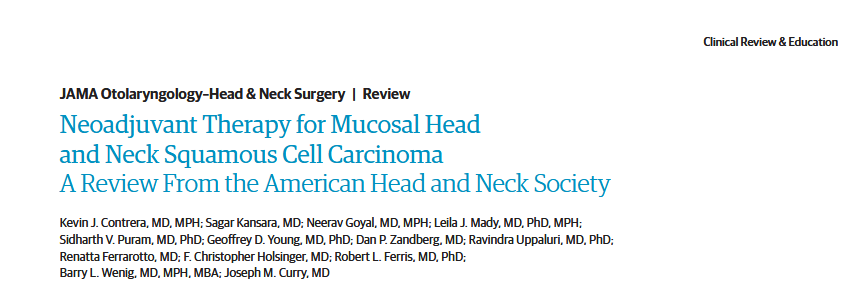An article on behalf of the American Head & Neck Society has been published in JAMA, led by Dr. Kevin Contrera, MD, MPH, Assistant Professor, Department of Otolaryngology-Head & Neck Surgery at the University of Pittsburgh. This article reviews the current data on using frontline systemic therapy to try to shrink tumor and personalize treatment, serving as a standard reference for advancing the next frontier of head and neck cancer (HNC) treatment.
In a JAMA Otolaryngology-Head & Neck Surgery Author Interviews podcast, Dr. Contrera said it is an exciting time in oncology. “The field is on the precipice of a major sea change,” he added. “And I think it’s in this direction of precision oncology.”
The article, “Neoadjuvant Therapy for Mucosal Head and Neck Squamous Cell Carcinoma,” is a narrative review to address current literature, evolving research, and gaps in knowledge surrounding neoadjuvant therapy. The abstract states, “While neoadjuvant chemotherapy for head and neck squamous cell carcinoma dates to the earliest multidisciplinary approaches, the introduction of immune checkpoint inhibitors (ICIs) has renewed enthusiasm and research into its use. Although neoadjuvant therapy has remained mostly investigative through single-institutional clinical trials for mucosal head and neck squamous cell carcinoma, new data have emerged to support its use.”
Head and neck squamous cell carcinoma is the seventh most prevalent cancer worldwide, with an estimated 890,000 new patients diagnosed each year and 450,000 deaths annually, according to the paper’s introduction.
In the podcast, Dr. Contrera said that HNC stands to benefit the most from the potential of neoadjuvant therapy. Looking at the functional impact of HNC, millimeters make all the difference. He said taking 40% of someone’s tongue versus 20% can mean the difference in them speaking, swallowing, functioning, and participating in society. “There’s a real opportunity with neoadjuvant therapy for some patients to be able to adapt their treatment in a way that’s personalized, and in turn, both gives them a cure but also minimizes the side effects of treatment,“ he added.
He talked about a trial at the University of Pittsburgh under Dr. Robert Ferris and Dan Zandberg that uses a combination of immune checkpoint inhibitors that has seen major responses in patients – to the point where surgeons expect to remove the tumor but there is none left. Any patient able to achieve a greater than 50% response has not had recurrence of disease thus far. “This highlights the exciting parts of this,” Dr. Contrera said, “because if you can select for the patients who are going to respond and then in turn adapt your treatments accordingly, you can really have an unparallelled impact on patients and their care.”
The precision opportunity is exciting, but there is still a lot of work to be done in figuring out which patients will respond best, and which agents will be best for certain patients, Dr. Contrera said. “There’s a lot of different tools at our disposal,” he continued. “There’s excitement about immunotherapy, but there are many different types. Is a combination better? How many times should we use a drug before surgery? At this current stage, we’re really in the earliest developments of what’s to come.”
